
Ian Lowe is a transplanted Texan living in Tasmania. He’s also one of the world’s most knowledgeable figures in the world of baking bread. I first heard about him from fellow bakers who led me to his writing on The Fresh Loaf. Later I spent lots of time on his Instagram page, A Piece of Bread, a place where he so generously (and imaginatively) shares his passion for baking and bread. And two years ago Ian started a Substack site, Ars Pistorica.
Tapping into so many of his formulas over the years, and fascinated by his exploration of the science of baking, for me Ian gives expression to the richness any baker feels for this craft, recognizing it as much more than something involving flour, water and salt. Back in 2015, I decided to reach out to him, and even though we had never been introduced, I invited him to do an interview with Stir the Pots. He was kind enough to agree.
Though nearly ten years old, with much happening in his life between then and now, reading it we still think there’s much to share. Tell us if you agree.
What brought you into baking?
Children are told a cautionary myth about jail, that they only feed you bread and water. As a kid I thought, that’s pretty awesome. Simply put, bread is my favorite food. Always has been, always will be.
I was raised in Texas, where bad food and large portions abound. I remember being young and being attracted to European “old world” breads and pastries. They were handmade, imperfect, and so different from the industrial, pre-packaged and under-baked goods I was familiar with.
When did you develop an interest in sourdoughs?
My first memory of sourdough is from the 1980s, and a really bad restaurant in Houston called “The Old San Francisco Steakhouse.” It’s a place with pictures of topless women in the bathrooms. And they had an act where a woman, dressed like a saloon dancer from the gold rush, would come out every hour, then sit on this swing hung from these high ceilings, swinging back and forth until she could kick a set of bells that were also suspended from the ceiling. Interestingly enough, there’s a video of it on YouTube.
True to their theme, they served “San Francisco sourdough” rolls; small, tidy-white and with a mouth-puckering sourness. Looking back on it, they were probably yeasted, retarded and artificially soured with acetic or lactic acids from a packet mix. No matter. I was hooked. To this day I prefer an acetic tinge in all my breads. But my food consciousness awoke in my late teens, when I lived in Arizona and Kansas.
What other inspirations around bread stand out in your memory?
In Phoenix in the late 1990s, I was lucky to be a regular of Chris Bianco‘s, long before he became “Chris Bianco.” From him I learned the importance of using and actively supporting what’s around you. In Kansas, I was fortunate to be a regular at WheatFields Bakery during Thom Leonard’s days there. The bread from those times remain among the best I’ve had to this day.
Best you can, share the timeline of your entry into working in this business. Say after high-school.
I went to four universities. I’d use student loans to fly to New York City to dine out at all its best restaurants. I eventually figured, why not just move there and have them pay me to work in them? So, I dropped out, sold my car, and moved across country to New York. Two places had a lasting impact on me as a baker.
First, Sullivan St Bakery. This was back when it was still actually on Sullivan Street. I’ve always been attracted to the small, the simple, the rustic. Jim Lahey made a number of products that were unlike anything I’d ever eaten before or had only read about in Fields’ “The Italian Baker.” Even if they are ubiquitous now, back then, they were fresh! Things like pizza bianca; schiacciata d’uva (wine grapes! olive oil! sugar! fennel seeds!); lumaca (a “snail” breakfast pastry made from a rough-puff cream cheese dough studded inside with currants, apricot jam, cinnamon, and walnuts, unfortunately no longer made); dark, bran-crusted filoni; stirati; thin, room-temperature Roman-style pizze; ossi di morti; biscotti pratese (his take on cantucci).
The other bakery was Pâtisserie Claude, which I’ve written about on my Instagram Feed. Those two bakeries are the influences that inform my bread and style to this day.
When you think of what falls first into making a good baker, how would you prioritize things like the science of bread, the craft, or the artigianalità ? What’s most important?
For me these sorts of questions are unanswerable. There are likely hundreds of thousands of attributes that can make a great baker. Most of which, we’ll never understand. Luckily, this creates diversity, giving us, as eaters, a variety of breads to consume.

Holey bread, or even crumb? Trends, style?
Both! Or, more accurately, whichever a baker wants it to be. I adore all bread.
There are two corollary issues in your question, both of which I’ll explore somewhat in-depth. The first has to do with grain (or flour) choice.
Large alveoli, of the kind you’re referring to, are only realized in a subset of a subset of a subset of all the breads in the world; ones made predominantly with flour from bread wheat. Or Triticum aestivum cultivars that possess a high concentration of the particular high-molecular weight (HMW) glutenin. The subunits that confer elasticity—known as subunits 5 and 10 and encoded by chromosome ID, as well as subunit 1, coded by chromosome 1A.
The relative presence of these subunits alone accounts for approximately one-half to two-thirds of the variation in strength between wheat doughs. They act as a more reliable indicator of how a flour will perform—how “strong” it’ll be—rather than total protein or “gluten” content.
The genetic basis for identifying these subunits has been known since at least the early 1980s. But it has rarely informed decisions in wheat-breeding programs, which are driven by the economics of global commodity-grain industry. Of course, other factors determine protein type and amount; like growing conditions. And grains should be bred for more than just particular peptide distributions. Breeding for matters of taste, suitability to local climates and ecology must also enter the equation.
The hard bread-wheat possess unusually high amounts of these subunits. They represent a tiny sliver of all strains grown throughout the globe. The vast majority are found in North America, and with tiny pockets scattered here and there, like Australia, Turkey, northern Europe and parts of Russia.
The primary definition of dough strength is “resistance to extension,” which basically means elasticity. Most of the rheological tests available to millers and cereal scientists are just variations on this one theme: how much does a dough snap back and in what ways? There are other aspects to dough strength, but they are negligible since most millable-bread-wheats exhibit a degree of uniformity in these characteristics. The largest producers of bread wheat—by far, I might add—are China and India, both of which together grow more wheat than all these other countries combined.
In order to answer your question, two questions must be asked: Is having these particular subunits (and hence lots of elasticity) desirable in the first place? And what are the consequences of selecting grains for these subunits?
The first answer is, not all European-style “artisan” breads require such elasticity. In terms of actual flavor, I do not prefer sourdough wheat breads made with such flour. There are simply too many enzymatic flavors present for my taste, masking the subtle, sweet grain characteristics that I love. Certainly industrialized bread makers prefer such flours because it allows
“greater tolerance” to their dough-making methods, which basically means they can more readily abuse the hell out of it and achieve higher yields.
The second question is trickier. Achieving greater levels of high-molecular weight proteins requires abundant nitrogen amounts in soil. As global climate change increases average temperatures, the N amount required to produce the same HMW levels will almost double in the next several decades. We must ask ourselves, is this sustainable, especially when most wheat regimes are grown in mono-cropped conditions, even when done so organically? This backdrop is needed to fully answer your question.
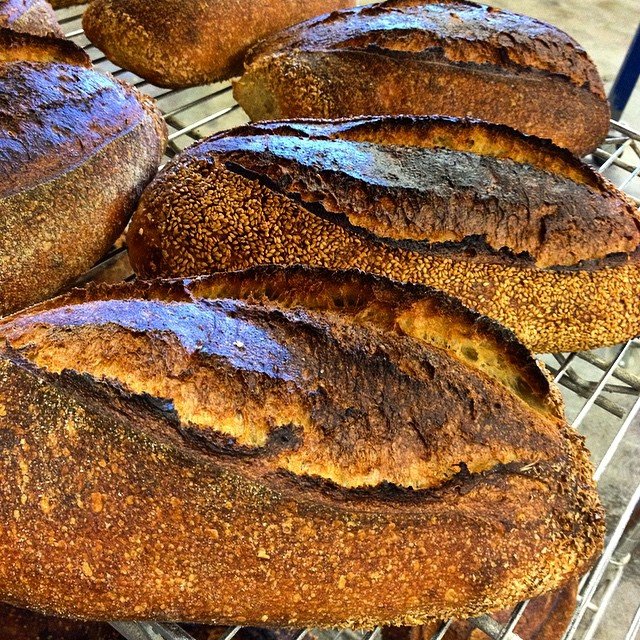
Large, gaping holes in round or oval hearth loaves are directly correlated to the presence of these particular glutenin subunits, for two reasons. First, the longer and thicker the gluten polymers that can be formed, the thicker the average “air bubble” cell wall can be. Second, the more elastic these cell walls can be, the larger it can get without popping. Simply put, it can be filled with more carbon-dioxide than “weaker” flours and undergo a higher degree of deformation without breaking.
The nucleation sites that eventually become these air bubbles are all created during the first few minutes of mixing. The more water there initially is—before gluten bonds are formed through cross-linking—the more air that can be entrapped in the dough system, up to a point. Water creates plasticity in gluten polymers, allowing them to deform to a greater degree, and additionally creates more irregular voids between gluten bonding sites.
As air incorporation increases so do the potential nucleation sites for air bubbles, again up until a saturation point, after which any mechanical “mixing” activity begins to subdivide existing bubble sites into smaller sizes.
To achieve larger air pockets, then, flour choice is the most important process parameter, followed by dough formulation (degree of initial hydration) and then mixing (degree of air and energy input during dough development).
There are other considerations but they matter much less.
I mention all this because I hope to show that there are many “kinds” of irregularity that can be achieved, much of it flour-, formula- and process-dependent.
What I think your question is really asking about is the current obsession, spawned by the photos and approach described in the two Tartine bread books, where hard North American wheat flours are super-hydrated and under-developed. The result is well-known: relatively squat, large-format “country” loaves made predominantly from low-extraction, roller-milled flour, with a crumb shot through with eyeball-sized holes surrounded by thicker, chewy strands of dough resulting from a fat, aggregated strands of gluten polymers.
Loaves made in this style do not have as much air entrapped, due to their mixing style and degree of hydration, resulting in a lower volume and a smaller amount of total air bubbles. However, the air bubbles that do exist tend to display a larger average size than more developed crumbs, and a photo negative of such a crumb’s cross-section would show amoeba-like ink blots.
I have nothing for or against this style. I am more interested in the bigger picture, and this whole process seems a reaction to industrialized bread, trudging to an extreme in the other direction.
That’s funny to me, because it employs a “liquid” starter, as do most North American “artisan” bakers, a leavening process created specifically for factory-made breads. Smaller German bakeries began employing simple liquid leaven machines in the 1980s. These were originally invented for factory breads in the former USSR and Germany. All for type-II sourdough rye breads, which use long-fermented, low pH starters that are completely devoid of yeast. In this process, they are merely used to acidify the rye dough. Yeast is added if a lighter dough is desired.
French baking companies branded their own versions in the nineties, all for “convenience.” The resulting French breads were never meant be sourdough-only, and, in fact, the levain liquide was seen as a natural dough improver to be used alongside commercial yeast. Artisan bakers from the States, training in France at this time, took this liquid starter, which was easier to mix but not quite as complex-tasting, and brought it back to the States, leaving the technological side behind. Independent French bakers were “sold” onto the idea of the superiority of liquid leavening primarily through advertising literature that accompanied the leaven machines; they internalised these ideals (easier to use, not “harsh” tasting), in turn influencing American bakers, until it’s become the most popular form of natural leavening in most modern, independent bakeries. In most “poorer” European countries where bakeries have not been penetrated as much by automation and where type-I wheat sourdoughs are still made, stiff starters remain the norm.)
My only worry is that most amateur bakers try to mimic this style without realizing they may not have access to an appropriate flour. As a result, their loaves may handle the amount of water called for, but their crumbs will lack the larger average bubble size, since most will have deformed and coalesced into small- to medium-sized bubbles—all because their flour didn’t have enough elasticity.
I personally prefer mid-level protein flours that exhibit a moderate degree of elasticity, at least for oval or round hearth loaves, with approximately 11% to 12% total protein. I also “develop” more than those working in the Tartine style; that is, I introduce more air at the mixing stage, as I like the resulting volume and the “fineness” it imparts to gluten strands, making for a less waxy, chewy crumb. By no means do we develop to a high degree in the bowl, and, in fact, none of our doughs would pass a window-pane test for even “moderate” development at the end of mixing.
For baguettes, I prefer low-to-medium protein levels, between 10.5% to 11.5% total protein. I am sort of a baguette enthusiast, and hate baguettes that have chewy, thicker crusts, the most common style found in “new world” artisan bakeries. Interestingly, our baguettes have a much more open crumb than our larger-sized loaves, mostly by design. Baguettes, since they are flatter in style, are eaten differently than bigger breads. Most people cut a baguette in half horizontally to fill it, whereas larger breads are cut into cross-sections (like toast) from the top down. These cross-sections are then laid down flat, where top-to-bottom alveoli are displayed.
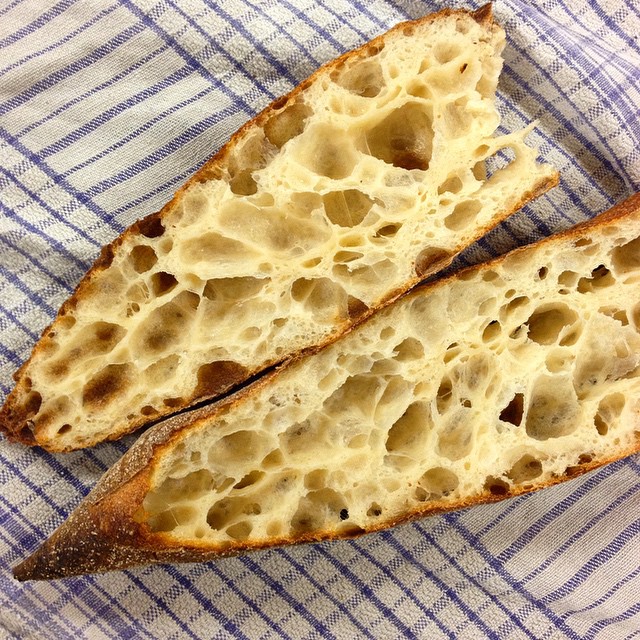
For me, larger holes don’t work quite as well in this scenario, because fillings fall through, whereas baguettes (or any flatter-style loaf) present a different cross-section: their alveoli are east-west, with a crust underneath to catch any fillings. Here, we pay attention to function after flavour. Aesthetics are a distant third.
Where does your inspiration come from?
For me it’s about making something I love. I have a rule at the bakery, we only make products we love. Otherwise, what’s the point? I’m not sure I can speak for anybody else, though.
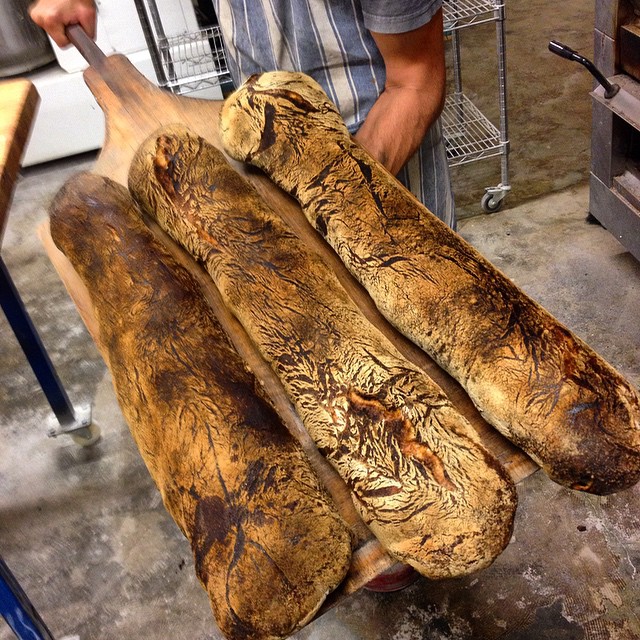
Gluten free, fad, not quite sure or what?
Anything explicitly labelled “gluten-free” is a fad. Anything that’s naturally gluten-free—which is to say 99.9999% of all foodstuffs—is not.
The “GF” dietary trend is nothing new. It’s Atkins or South Beach by another name and confined to a small percentage of the global population, primarily in rich countries that consume a “Western” industrialized diet.
It’s sort of a cyclical thing we’ve seen the past two decades that’ll die down soon enough before being re-branded under a different name. It’s also mostly beside the point, as are most “diets,” be it a “cleanse” or a “detox” or “paleo” or what have you.
The bigger picture is, we should eat as local and as fresh and as whole and as diverse a foodstuff as possible, carbohydrate sources included. It’s boring, unhealthy and ecologically disastrous otherwise.
Only very recently has medicine shifted notionally to become about fixing after rather than being inclusive during. What and how we eat needs to re-enter our discussions about what constitutes long-term health, re-framing it as an ongoing and participatory process.
To put all this another way: I regularly eat gluten-free (and vegan and raw). Why? Eating only seeds from Triticeae grasses is boring. Balanced, diverse dietary sources are tastier and more engaging.
What do you think about while baking?
While baking I think about the same things I do when not baking: Baking. It’s my obsession. I cannot turn it off. I have Asperger’s. This inability to “switch off” causes me a lot of lost sleep.
Ancient grains are on a revival. What are you trying?
I’m not sure I know what an “ancient” grain is.
How hard is it to start a small bakery?
It’s not easier or harder than anything else in life. It’s just a matter of doing it, again like anything. Doing it well consistently is another matter.
Baking, like any restaurant job, is very much a team sport, and we run things based on consensus. A group decision goes into everything we do, from which ingredients we source and why to the sort of formulations or processing methods we use. If my team were not engaged with the product, then it’d turn out mediocre or worse. Although “I” am the face of Apiece, “I” would be nothing without the people I work with. They breathe just as much life into our products, and are as integral to what we do.
What bakers inspire you?
That list is way too long to name. It’s my belief that a person can learn something from everybody and everywhere. I obsessively read about as many bakers and chefs and pastry chefs as possible. I’m a junkie and a self-described “formula whore.” I love information.
Four bakers I immensely admire are Thom Leonard, Phil Agnew and the Bianco brothers, Chris and Marco. These are all people I have some kind of a personal connection to and whose handiwork I’ve eaten enough to know inside out. Lucky me.
Then there’s a small band of wonderful independent bakers here who are becoming the new face of baking down under. All are friends and wonderful people, many of whom I used to work alongside at the shaping bench.
Tim Beylie, @bakerbeylie (currently a for-hire ronin), who possesses the best shaping skills I’ve ever seen; Mike James, @tivoliroadbakery, and his awesome crew Emily, Christine and Jo at Tivoli Road Bakery.
Will, @bakerwilly, and his partner on the Gold Coast.
Emily Salkeld, @lilybev, at Small World Bakery
Andrea Brabazon at Loafer Bread, @loaferbread.
And Dan Cruden, @danthebakerdownunder, in Auckland. These are all awesome people first and great bakers second, and are as open and sharing as I aspire to be.
Is pizza a bread too?
Yes. There are others who wouldn’t agree but it’s mostly semantic.
A question I often ask myself is, what is bread? The best answer I’ve found is, it’s a starchy paste made from ground or crumbled seeds or tubers mixed with water. Sometimes this mixture has salt, sometimes not. It’s often fermented, but occasionally not. It can be consumed raw or dried or even gelatinized by high heat. It can be liquid or solid and every texture in between.
Are noodles bread? If not, why? Many rice noodles in southeast Asian countries are made from a slurry that undergoes lactic-acid fermentation to lower pH, providing shelf stability at ambient temperatures. How is this different than bread?
Is beer bread? Most “beers” in Africa and poorer Asian countries are small-scale, naturally-fermented, unpasteurized and processed from whichever local grains or tubers are present. In which ways is this different than bread?
Is porridge bread? And so on it goes. I ask all these questions earnestly. For me, the answer to all is yes.
“Bread,” then, is a process—not just a foodstuff—developed very recently in our history (between ten to fifty thousand years ago) for providing nutrient-dense, plant-based carbohydrate sources into the human diet. This process was likely created because, as a species, we shy from boredom and like what’s new.
Tell us about writing your book, which seems to being created on Instagram.
I’ve given myself a deadline of five years to complete “it,” but it’s a goal post that keeps moving. I’ve always been interested in the macro. My writing follows suit. What are the underlying, generative principles involved, and how does one elegantly summarize them?
No bread book teaches its readers how to create her own formula from scratch, without the need of outside sources. That’s my aim. To elucidate the true fundamentals so a reader emerges with theunderstanding of the variables that most determine a particular outcome and how to manipulate them to attain a desired outcome.
My Instagram account is more about bread education and community building than anything else; it acts as a non-systematic conduit for my always-on-the-go mind or sharing the fruits of my research.
Maybe I should self-publish in smaller, serialized volumes centered around a particular topic? All bread for thought.
The Modernist Cuisine folks are publishing their bread tome soon, with the aid of Francisco Migoya and Peter Reinhart. It’ll be interesting to see their take on a “science-based” approach, although I’m skeptical.
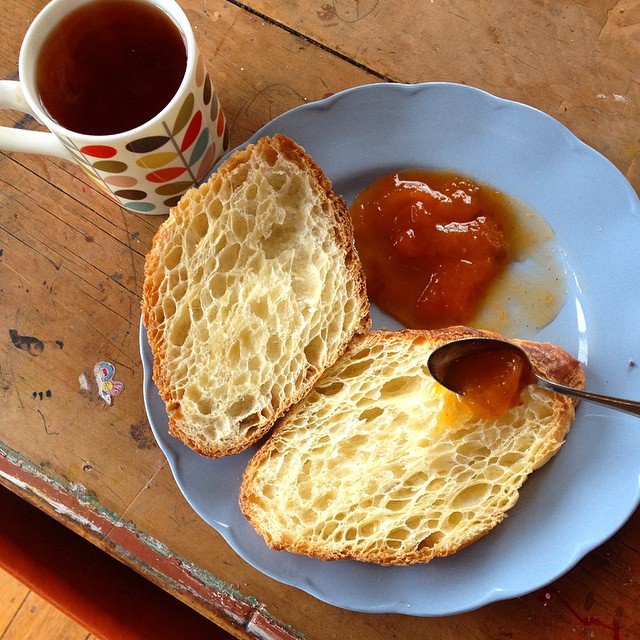
“Il faut être grand, fort, et bête.” (“You must be big, strong, and stupid.”)
–Jean-Luc Poujauran, on what it takes to be a great baker.
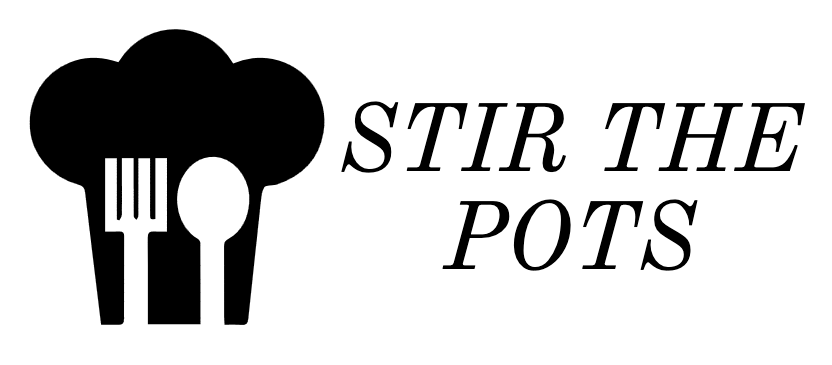
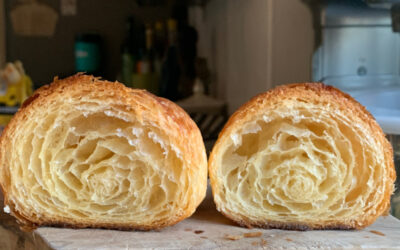
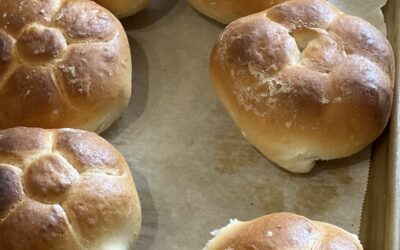

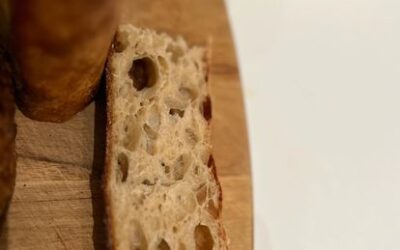
0 Comments